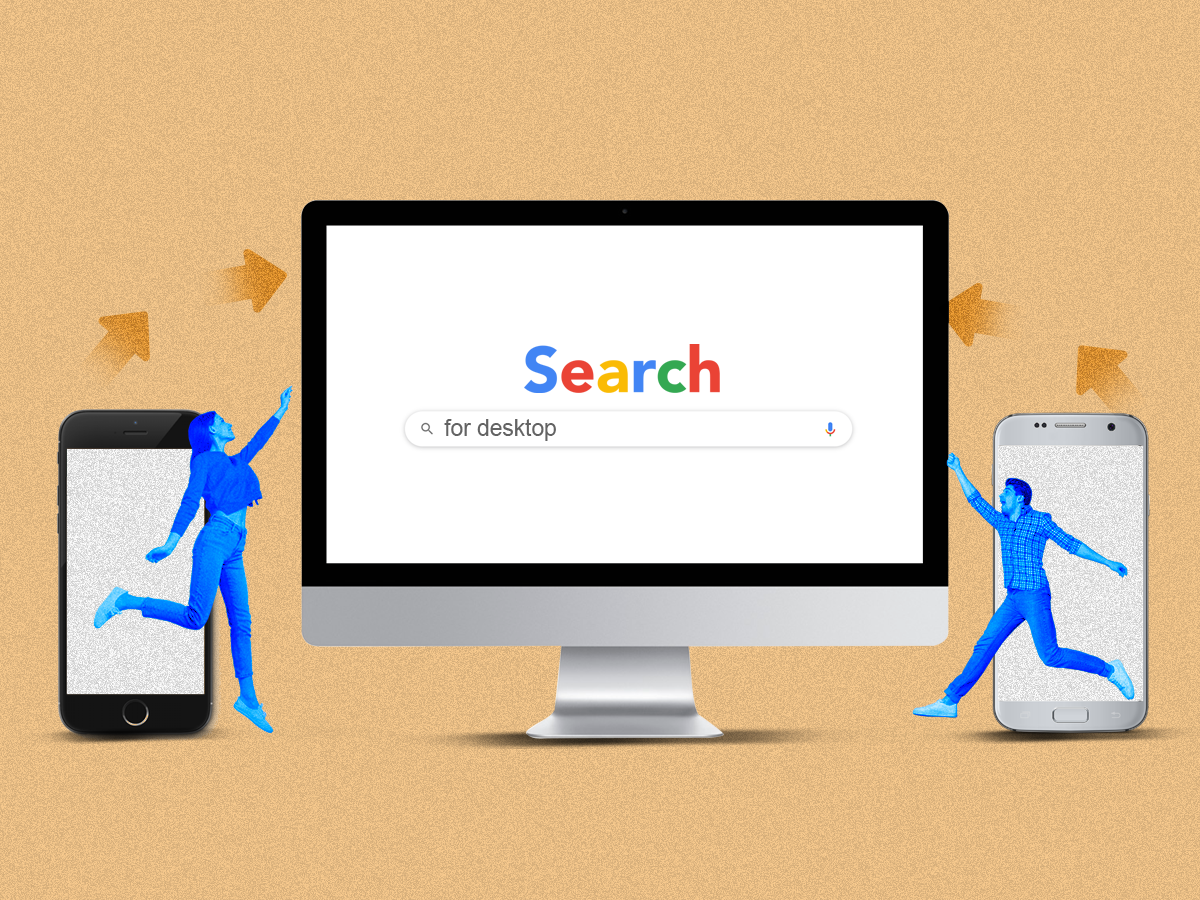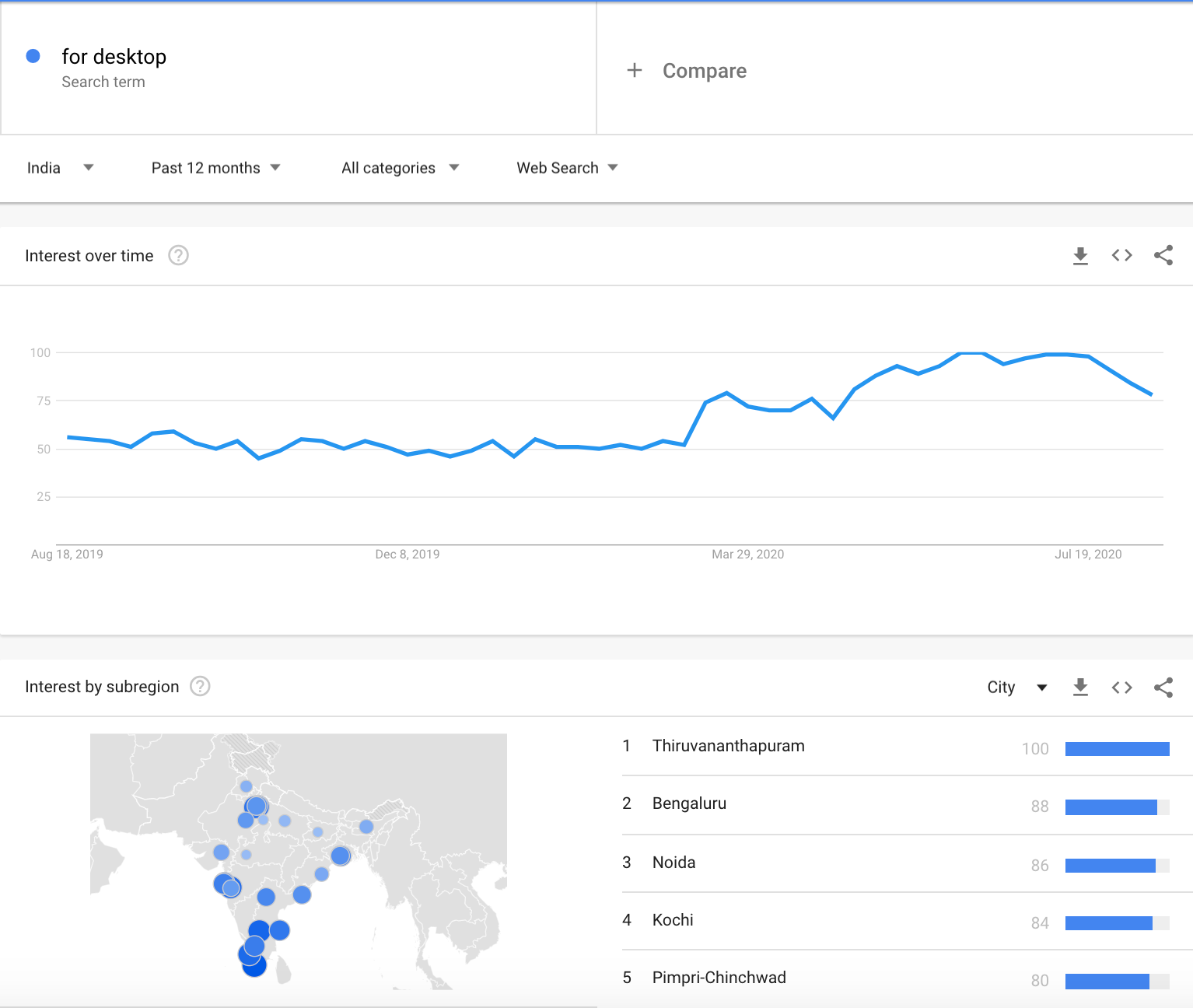
India’s urban professionals are reverse migrating to desktops from mobiles during the pandemic, as hundreds of thousands of them relinquish their “always on the move” tag to work from home.
According to Google Trends for India, interest in queries with the term “for desktop” rose sharply starting in March, when the lockdown began, and peaked at 100 — the top interest score — twice in both June and July. This was based on an analysis of the search term over the past 12 months as on August 13. Thiruvananthapuram, Bengaluru and Noida were the top three cities that contributed to this rise in interest.
“Microsoft Teams for desktop”, “Telegram web” and “Google Meet for desktop” were among the top five breakout queries leading to the spike in search, according to data available on Google Trends India.
App- or mobile-first Internet companies told ET their web traffic from tier 1 cities grew considerably compared to pre-lockdown days.
Ecommerce major Flipkart’s desktop traffic had been on the decline over the years, a company spokesperson says. “However, in the past few months, desktop traffic has been steady.”
There was a 37% increase in Spotify’s listeners using the desktop version of its app in urban India between April and June compared with 7% growth between November 2019 and January 2020, says a spokesperson for the music-streaming service.
As per anthropologist Gayatri Sapru, urban Indians spending more time in front of ‘permanent’ devices like PCs and laptops is also affecting the kind of content people read and share because of the kind of screen they are using.
Digital media companies are seeing this shift first-hand now.
“Usually, business news has very high desktop traction due to workplace consumption. During the lockdown, though, lifestyle, gadgets and entertainment content also saw their desktop traffic share rise by 10-15%,” says Vivek Pandey, vice president of revenue strategy & analytics at Times Internet, the digital arm of the Times Group that includes The Economic Times.
At Verloop, a customer support automation platform, “customer usage of mobile-support platforms for app-first businesses like ecommerce and fintech dropped from 70% pre-lockdown to 54.83% now,” founder Gaurav Singh says. This indicates that relatively more customers are using desktops for ecommerce during the lockdown and raising more support tickets from desktops than mobiles.
Digital media planners also highlight that professionals looking to enhance productivity while working from home make for the majority of urbanites migrating from mobile to desktop.

There’s an uptick in demand of web extensions like time trackers, ad blockers, writing tools (like Notion, Evernote) and VPN access, notes Suhas Motwani, cofounder of Indistractable, an app for productivity tools.
At GajShield Infotech, a data cloud and network security solutions provider, 80% of VPN traffic before Covid was through mobile devices including tablets. “Post-Covid, almost 70% of the global traffic for our VPN offering has been from desktop devices, majority of it coming from IT professionals living in India at present,” says company CEO Sonit Jain.
Big Tech’s Desktop Focus
This lockdown trend coincides with tech companies Facebook and Twitter rolling out features to enhance the user experience for Web.
In April, Facebook-owned Instagram introduced direct messaging for its web version, a feature earlier available only on the photo-video-sharing platform’s mobile app.
“We started testing it with a small percentage of users globally and then made it more widely available,” a Facebook spokesperson told ET. Simultaneously, Instagram introduced the ability to watch live videos on its desktop version.
In early July, Facebook’s messaging platform WhatsApp introduced the dark mode for its web version and desktop app. Shortly after, Twitter rolled out a separate pop-up window for direct messages on its web version so that users didn’t have to leave their timelines to check messages.
That said, digital media planners also point out that this reverse migration from mobile to desktop is confined to a small percentage of affluent working Indians — about 1 million top working professionals — who can afford Windows or Apple desktops and laptops, or are using their office laptops at home during this period.
However, this subset of people contributes to a large chunk of business, says Gautam Mehra, the chief data officer at Dentsu Aegis Network. “Roughly, around 40 million people buy online in India. Of these, about 1 million of them contribute to 30% of all ecommerce. And a good number of people from this 1-million subset are definitely using more desktops right now,” he adds.
Small but Significant
The likes of Mehra call this trend is a great opportunity to target affluent Indians through desktop advertisements, but add that it is a Catch-22 situation for them as most companies that aim for the high-end segment are not advertising right now.
“There are many brand media plans that have not gone live for months. Everyone is in a starting out phase right now. So that’s affecting a quick action on this trend,” Mehra says.
Meanwhile, Himanshu Khanna, the founder of New Delhi-based design and tech company Sparklin, is seeing new demand coming in from clients in categories like banking, fintech and B2B sectors, who want him to focus on their presence on desktop and tablet first.
Online payments via desktops have not seen a big jump though. “Perhaps a 4%-5% hike during these times at best,” says Navin Surya, the chairman of the Fintech Convergence Council and the chairman emeritus of the Payments Council of India. Surya explains this is because net banking was already big on desktop, especially for high-value transactions. “Perhaps some of the personal payments people made through mobile while in office might be happening via desktops during the lockdown now.”
Karthik Rao, a cofounder of online-first, custom PC desktop seller Kraft PC, has seen a 30%-35% growth in demand for custom desktops from people keen to set up home workstations, and a 100% increase from content creators who have to maintain quality output even though they can’t go to studios for post-production during the lockdown.
Desktops have always been a preferred platform than mobile for user experience and for info-heavy interactions as well, says Khanna of Sparklin. “It allows you to handle a lot of use cases at the same time without causing clutter and provides amazing real estate for user engagement. That is why you see people leaving a footnote saying ‘Sent from my mobile, excuse typos’ when answering emails from their smartphones.”
It is for this reason, perhaps, that YouTube Music got a separate desktop version even where there already is a YouTube for web. Designed in May 2018, it was launched in India in March 2019. “In order to give users a listening-optimised experience and allow them to effortlessly explore the world of music that is available on YouTube, a separate app and desktop player is the best way,” says a YouTube spokesperson.
Going forward, too, “info-heavy focused platforms will prioritise for desktop innovations while messaging or casual social-interaction platforms will focus on mobile first,” concludes Khanna.
Leave a Reply